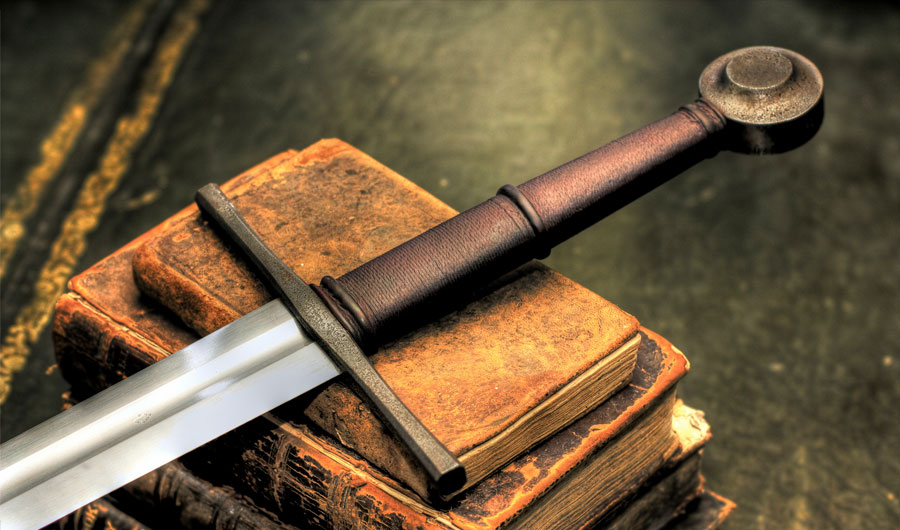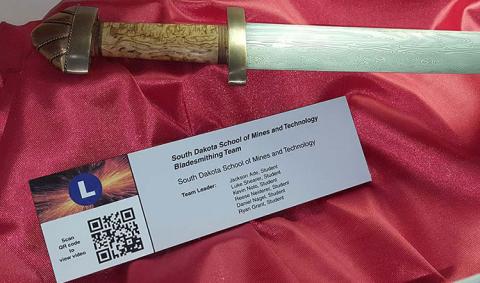Students Forge Swords to Sharpen Science and Engineering Skills

Image credits: Søren Niedziella via flickr (home page teaser image is in the public domain)
Rights information: CC by 2.0
(Inside Science) -- Artisans and craftsmen once forged swords and other metalwork in the searing heat of furnaces and pounded the glowing metal into shape with hammers and anvils, using methods developed over generations. After nearly disappearing in the 1900s due to automation, the science and art of smithing blades by hand is back on display in the biennial bladesmithing competition organized by The Minerals, Metals & Materials Society.
Undergraduate and graduate students from 26 universities in the U.S., Canada, Norway and Indonesia took part in the contest on Feb. 28 at the society's meeting in San Diego. Many participants study mechanical or materials engineering, and the competition gives them the chance to use knowledge they learned in the classroom, while trying their hands at an ancient and evolving profession.
“There’s this really interesting marriage of science, metallurgy and engineering with archaeology and the aesthetic side of the craft as well, and we were involved in all of those aspects of the process,” said Luke Shearer, a member of a team from South Dakota School of Mines and Technology in Rapid City.
Shearer and his teammates won the grand prize with their 336-layered steel sword, inspired by a 9th century Norwegian short sword known as a langseax. They navigated many challenging steps, from melting metal out of rocks to exposing the blade to a series of precise temperature changes, which altered its hardness and toughness. The many layers give the metal a distinct look, similar to the swirling patterns on a soap bubble.
A team of students from the Norwegian University of Science and Technology came in second place with their reproduction of a late Iron Age Viking sword native to their region of the country, near Trondheim. A straight shaving razor, made of layered steel resembling alloys developed in medieval Damascus, earned Colorado School of Mines students third place recognition. Honorable mention went to a rapier made by students at California Polytechnic State University in San Luis Obispo.
Any type of blade was allowed, as long as it was between 20 and 120 cm long, including the handle. Students were also required to present their work in a poster and a 5-minute video, helping them develop their communication skills.
“I was surprised by how much we learned. It really boosted our confidence as we improved on our mistakes and created something new,” said Eric Tenuta, another contestant and McMaster University student in Ontario, Canada.
Many students enjoyed the hands-on learning. Some groups built their own forge or furnace or even hammered their blade by hand on an actual anvil. After they forge the blade, they do some rough grinding and heat treatment, which changes the microscopic structure of the metal and affects both its strength and flexibility. This step presents risk as well, because as the metal heats, it can crack or tear apart.
The teams relied on the engineering and science they’ve learned, including chemistry, metallurgy, physics and thermodynamics. Heating a blade for too long, or changing its temperature too quickly could ruin it. The teams' projects also included plenty of experimentation, and some students plan to publish what they’ve learned in a scientific journal.
The creative aspect of the process provides an additional challenge. Some people smelt their own ore, with one group including ore from a meteorite, while another in the previous competition extracted material from California beach sand. In addition to more traditional swords, participants also produced a bowie knife, a throwing knife, a battle axe, an Indonesian dagger, an Elven shortsword, and a Beowulf-inspired single-edged knife.
“I really didn’t want to just make something sharp and pointy. I wanted it to be more than that,” said Dylan Fitz-Gerald, leader of the team from California Polytechnic State University. He designed and built artistic ivy leaf patterns connected to the handle of their rapier, while a teammate made an ornamental cross-guard and another attached a pommel to the end.
Organizers of the competition emphasize the importance of safety. Considering the well-known dangers in this line of work, they encourage the students to take precautions including wearing protective gear, like gloves, goggles, ear plugs and dust masks.
“I’m amazed by how enthused and enthralled the students and [society] members are in this,” said Stanley Howard, who serves as president of the organization and started the competition two years ago. According to Howard, it draws students in while encouraging them to better understand the history of metalworking. The participants often continue to pursue their interests as researchers in the field and workers in the industry, he said.


